Bonding - Properties of Ionic Bonding (A-Level Chemistry)
Properties of Ionic Bonding
Definitions
A compound is formed when two or more elements join together, forming bonds between them. E.g. Carbon dioxide is a compound formed from carbon and oxygen atoms joining together.

An ionic bond is the bond formed between positively charged and negatively charged ions (oppositely charged ions) due to the electrostatic forces of attraction between them.
A lattice is a regular structure.

Ionic Compounds
Ionic Bonding
- An ionic bond forms as result of electron transfer. The transfer of electrons between metal and non-metal atoms results in the formation of oppositely charged ions, which are strongly attracted to each other by electrostatic forces, forming ionic bonds.
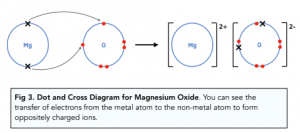
- The overall charge of any ionic compound must be zero. If an ionic compound has an overall charge of zero, it must consist of ions with charges that balance each other out. E.g. NaCl (Sodium Chloride) is an ionic compound made of the ions Na+ (+1 charge) and Cl- (-1 charge) which balance out.
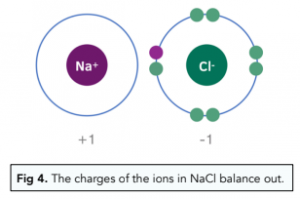
- The formula of a compound can be calculated by comparing the charges of the ions present in the compound. E.g. if there are two ions present in an ionic compound where one has a charge of +1 and the other has a charge of -2. Two positive ions will be needed to balance the charge of the -2 ion.
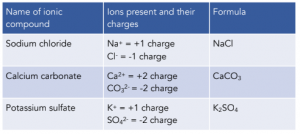
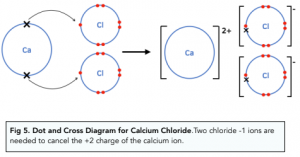
- The strength of ionic bonding depends on ionic charge. Bigger charges exert greater attractive forces between each other so the greater the charge on the ions involved, the stronger an ionic bond will be.
- The strength of ionic bonding depends on ionic radius. The smaller the ions, the more closely they can be packed together in the ionic lattice. The shorter the distance between oppositely charged ions, the stronger the electrostatic forces between them and hence the stronger the ionic bond.
- Ionic radius increases down a group. This is because as we go down a group, the number of outer electron shells increases.
- Ionic radius decreases along a period. This is because the number of electrons stays the same but the atomic number increases. Therefore, electrons are pulled in more strongly.
Ionic Structure
- Ionic compounds form crystals with a giant ionic lattice structure. A giant ionic lattice structure is a structure that has a regular arrangement. Something you should bear in mind is that giant in this case does not mean that the structure is large. In this context, giant means that it is indefinite to say exactly how many ions are present.
- Different ionic compounds form structures with different shapes. Some ionic compounds form giant ionic lattices that are cube shaped such as sodium chloride. However other ionic compounds form slightly different shaped structures.
- A giant ionic lattice consists of endless repeating basic units. The reason that a giant ionic lattice has a regular arrangement is because the units or crystals that it is made up of are exactly the same (repeating).
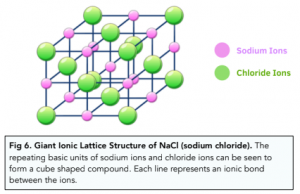
Physical Properties of Ionic Structures
- The physical properties of an ionic compound is determined by its structure. The arrangement of ions in the compound determines whether or not the compound can conduct electricity as well as the melting and boiling point of the compound.
- Ionic compounds have high melting and boiling points. The melting and boiling points of ionic compounds is usually quite high because the ions in the giant ionic lattices are held together by strong electrostatic forces of attraction acting in all directions which are difficult to overcome. A large amount of energy is needed to break these forces (ionic bonds) therefore a high temperature is required.
- Ionic compounds can only conduct electricity when molten or dissolved in solution. Ionic compounds can only conduct electricity when molten or dissolved because only then are the ions of the compound able to move and carry charge. Ionic compounds are unable to conduct electricity when solid because the ions are fixed in place and unable to carry charge.
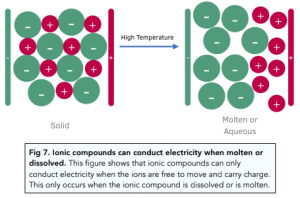
- Ionic compounds are soluble in water. Ionic compounds easily dissolve in water which means they are highly soluble in water. This is because both ionic compounds and water molecules are partially charged molecules (polar). This means the partial charges of water break apart the ionic lattice, pulling oppositely charged ions apart and the ionic compound to dissolve.
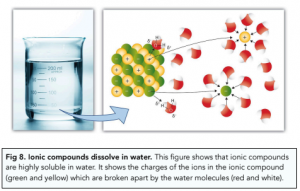
Evidence for the Presence of Ions
The current theory behind ionic bonding can be supported by the physical properties of ionic compounds. Moreover, the migration of ions also evidences that ions are present and this can be shown by electrolysis.
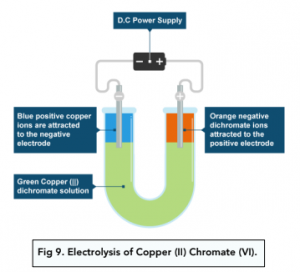
When a current is passed through a green solution of copper (II) chromate (VI), we can see how the solution closest to negative electrode turns blue and the solution closest to the positive electrode turns yellow.
Copper(II) ions are blue in solution whereas chromate (VI) ions are yellow. This experiment therefore visually shows the migration of the oppositely charged ions to the oppositely charged electrodes.
Bonding in chemistry refers to the interaction between atoms or molecules that results in the formation of a chemical bond.
Ionic bonding is a type of chemical bond formed between positive and negative ions. It occurs when electrons are transferred from one atom to another, resulting in the formation of positive and negative ions.
The properties of ionic bonding include high melting and boiling points, poor conductivity in solid state, and high conductivity in aqueous solutions.
Ionic bonding affects the physical properties of substances by creating strong bonds between ions. This results in high melting and boiling points, poor conductivity in solid state, and high conductivity in aqueous solutions.
Ionic bonding involves the transfer of electrons between atoms, whereas covalent bonding involves the sharing of electrons between atoms. Ionic bonding results in the formation of positive and negative ions, while covalent bonding results in the sharing of electrons between atoms.
The structure of ionic compounds is made up of positive and negative ions arranged in a repeating three-dimensional pattern. This structure gives ionic compounds their high melting and boiling points and poor conductivity in solid state.
Ionic bonds form between atoms when one atom gives up electrons to another atom, resulting in the formation of positive and negative ions. The attraction between these ions creates the ionic bond.
Common examples of ionic compounds include sodium chloride (NaCl), magnesium oxide (MgO), and calcium chloride (CaCl2).






Still got a question? Leave a comment
Leave a comment